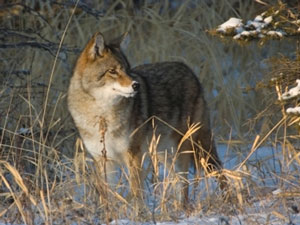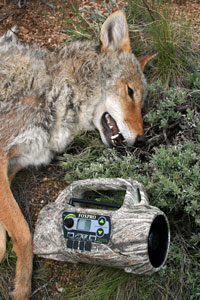
 Coyotes that will charge in eagerly to investigate a dying-rabbit call are becoming increasingly hard to find. If you like to hunt and kill coyotes today, you'll need to up your offerings, enthusiasm and standards when calling and attracting modern song dogs. Luckily, hunters are finding new methods and sounds to take on this old pest, which has spread from coast to coast in North America.
Coyotes that will charge in eagerly to investigate a dying-rabbit call are becoming increasingly hard to find. If you like to hunt and kill coyotes today, you'll need to up your offerings, enthusiasm and standards when calling and attracting modern song dogs. Luckily, hunters are finding new methods and sounds to take on this old pest, which has spread from coast to coast in North America.
Coyotes are quick learners and top students in the study of hunters — and their tactics. In areas where sluggish hunters have walked a few yards from the truck and then blown a rabbit-in-distress call relentlessly, coyotes will run away or pause at great distances to study the situation before coming near. To become more deadly, you'll need to plan an approach and call with a new song.
First and foremost, be more "green" (it's in these days anyway) by parking and walking a good distance from your vehicle before calling or setting up to hunt. Also, turn off the radio and do not slam vehicle doors as you prepare to leave your vehicle behind. Keep conversation with hunting partners to a minimum, and reduce or prevent noises that announce to the wild world that a hunter has entered the woods. Sounds carry a long distance on a crisp morning or evening, and any coyote that faintly hears a hunter will be on the move — away from your location. When you loose the element of surprise, you're simply wasting your time, while also making local coyotes harder to hunt. Be silent, and be deadly.
Before you call, pick a place to sit or kneel near cover. Hungry coyotes during winter and spring seasons can come with great enthusiasm when they hear an inviting meal. You'll need to be ready with little movement, or your plan will be revealed. And remember, coyotes are quick learners with long memories. Be ready before you begin sounding like a meal.
Talk to 'Em
Coyotes are well known for eating a wide assortment of foods from mice to watermelons. It's the noisy foods that coyotes hear and pursue — and that hunters want to imitate. And nearly any small rodent, bird or animal can catch a coyote's attention and bring it in to investigate. It's the over-used rabbit-in-distress call, however, that many coyotes seem to avoid these days. Select and use an animal sound that's not so associated with hunters.
Mouse squeaks, a nearby call in most situations, can bring in local coyotes that you've silently slipped in on. Mouse squeaks can be heard from a long distance on a still, calm morning. This minute sound is not the best choice, however, in a howling wind.
 |
| Today's super-loud electronic callers offer modern coyote hunters many new calling options. |
In recent hunting times, woodpeckers, the fussy song of a songbird, the boisterous caw of a crow, the call of a quail, and howling house cats have been used to entice a coyote into revealing itself. There are several sources for mouth-blown bird calls, but the cat call is only available on tape or CD for use with an electronic caller.
Electronic callers are more user-friendly, and louder, than previous models. These calls have also opened up opportunities to use the common rural and farm sounds that coyotes often associate with easy meals, like chickens and sheep. The list of these calls seems to be growing rapidly, and there is a good chance that any coyote that has not been over exposed to a new call on the market will come to investigate. Today's super-loud electronic calls also offer some new calling options. If you are so inclined and have the technology, you can record common barnyard sounds of piglets, calves and other species and play these afield when hunting. In farmland areas, the sounds are common, and coyotes in many areas have become more brazen about trying to take down young livestock. Use this to your hunting advantage.
Another call that hunters have predominately used to attract coyotes in the spring also works during the rest of the year-the call of nearly anything that talks wild turkey. I've had coyotes come in search of many basic box calls that sang, "I'm a tasty turkey over here." A long sequence of non-stop turkey squawking, cackling and fussing will bring any hungry coyote within ear shot running into your lap. And the good news is that many turkey calls are loud, so you should be heard with little effort.
Thinking beyond food sources when calling song dogs can also produce action. Coyotes are more inclined to be sociable in the winter because it's the breeding season. Any pup whine, excited howl or simple hello "yip" that sounds like a coyote could sound like an invitation to get together. And the good news is that non-aggressive coyote howls from a mouth blown call can carry a long distance in the dead calm of winter, so you can cover a lot of ground vocally and save your energy for dragging a dead coyote back to the truck. Just be certain to stay seated for at least 30 minutes after you cease calling to give the coyote time to reach you when using long-range calls. Many impatient hunters have stood up just as a coyote has come loping around a nearby bush.
Glass 'Em Up
Coyotes have keen eyesight and hearing. You need to be silent when moving and hunting to avoid being spotted. Spend hours glassing and peeking over ridge tops, much like you do when hunting mule deer and pronghorns, and move without being silhouetted on the sky line. Sooner or later you'll spot a coyote trotting up a valley or poking around in a distant pasture, and then it's only a matter of sneaking within range and releasing an accurate bullet.
Other hunters who use this spot-and-stalk method in the winter — when coyotes are always very hungry or searching for love — park their trucks along the edges of sprawling agricultural fields and then anchor a spotting scope atop a downed window. A better bet that's easier on the eyes is to use a high-power binocular on the mount; binoculars cause less eye strain and the resulting headache. Binoculars also help wipe out some of the annoying rocking that's often noticed as your truck sways in winter winds.
While dawn and dusk are always good times to seek and find coyotes out and prowling, they can generally be spotted any time of day during the winter months, especially on warm, sunny afternoons. During winter, coyotes also roam far and wide in search of road-killed deer, hunter tossed gut piles and even winter-weakened deer. If you can find the time to go hunting, get out there during the cold days of winter. You'll find it's easier to see and call great distances, and the coyotes are more cooperative, too.
- 6059 views

